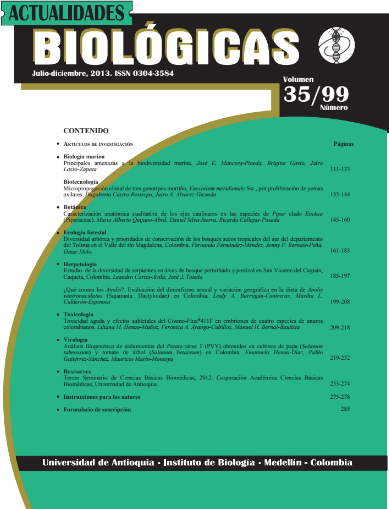Toxicidad aguda y efectos subletales del Cosmo-Flux®411F en embriones de cuatro especies de anuros colombianos
DOI:
https://doi.org/10.17533/udea.acbi.329119Palavras-chave:
anuros, Colombia, Cosmo-Flux®411F, desarrollo, embriones, tamaño corporalResumo
El Cosmo-Flux®411F es el coadyuvante principalmente mezclado con el herbicida glifosato para su aplicación en el control de cultivos ilícitos en Colombia y malezas en la agricultura. Sin embargo, no hay estudios que evalúen la toxicidad de este coadyuvante sobre los anuros, los cuales son altamente sensibles a los cambios ambientales. El objetivo de este estudio fue determinar la concentración letal media (CL50) y los efectos subletales (en el tamaño corporal y la tasa de desarrollo) que causa el Cosmo-Flux®411F en embriones de cuatro especies de anuros colombianos, expuestos bajo condiciones de laboratorio y microcosmos. Engystomops pustulosus fue la especie más tolerante al Cosmo-Flux®411F (CL50 laboratorio: 2.234,86 mg/l; CL50 microcosmos: 2.535,3 l/ha = 655,13 mg/l), seguida de Hypsiboas crepitans (CL50 laboratorio: 849,21 mg/l; CL50 microcosmos: 1.169,93 l/ha = 302,31 mg/l), mientras que las más sensibles fueron Rhinella marina en laboratorio (CL50: 495,18 mg/l) y R. humboldti en microcosmos (CL50: 478,2 l/ha = 123,59 mg/l). Comparando las concentraciones sugeridas de aplicación de 0,5 a 1 l/ha, con los resultados de los microcosmos, los cuales tuvieron un CL50 menor que los de laboratorio, el Cosmo-Flux®411F no mostró ningún efecto letal. Tampoco hubo efectos subletales en los individuos expuestos a concentraciones menores a los de CL50. Sólo en R. humboldti se apreció un retraso en el desarrollo a partir de una concentración 205 veces superior a la utilizada en campo. Por lo tanto, el Cosmo-Flux®411F, a la concentración sugerida de aplicación en campo, no produjo efectos letales ni cambios en el tamaño corporal y la tasa de desarrollo en los embriones de las especies de estudio.
Downloads
Referências
Belden LK, Blaustein AR. 2002. Exposure of red-legged frog embryos to ambient UV-B radiation in the field negatively affects larval growth and development. Oecologia, 130 (4): 551-554.
Bernal MH, Solomon KR, Carrasquilla G. 2009a. Toxicity of formulated glyphosate (Glyphos) and Cosmo-Flux to larval Colombian frogs 1. Laboratory acute toxicity. Journal of Toxicology and Environmental Health Part A, 72: 961-965.
Bernal MH, Solomon KR, Carrasquilla G. 2009b. Toxicity of formulated glyphosate (Glyphos) and Cosmo-Flux to larval and juvenile Colombian frogs 2. Field and laboratory microcosm acute toxicity. Journal of Toxicology and Environmental Health Part A, 72: 966-973.
Bernal MH, Alton LA, Cramp RL, Franklin CE. 2011. Does simultaneous UV-B exposure enhance the lethal and sub-lethal effects of aquatic hypoxia on developing anuran embryos and larvae? Journal of Comparative Physiology Part B, 181 (7): 973-980.
Bernal MH, Lynch JD. 2013. Thermal tolerance in anuran embryos with different reproductive modes: relationship to altitude. The Scientific World Journal, 2013: 1-7.
Cosmoagro [Internet]. 2012. Cosmoagro: Cosmo-Flux®411F. Fecha de acceso: 4 de diciembre de 2012. Disponible en: <http://www.cosmoagro.com/site/blog/cosmo-flux-411f/>.
Gosner KL. 1960. A simplified table for staging anuran embryos and larvae with notes on identification. Herpetologica, 16 (3): 183-190.
Guayara-Barragán MG, Bernal MH. 2012. Fecundidad y fertilidad en once especies de anuros colombianos con diferentes modos reproductivos. Caldasia, 34 (2): 483-496.
Henao-Muñoz LM, Bernal-Bautista MH. 2011. Tolerancia al pH en embriones y renacuajos de cuatro especies de anuros colombianos. Revista de la Academia Colombiana de Ciencias Exactas, Físicas y Naturales, 35 (134): 105-110.
Kats LB, Kiesecker JM, Chivers DP, Blaustein AR. 2000. Effects of UV-B radiation on anti-predator behavior in three species of amphibians. Ethology, 106 (10): 921-931.
Mann RM, Hyne RV, Choung CB, Wilson SP. 2009. Amphibians and agricultural chemicals: Review of the risk in a complex environment. Environmental Pollution, 157: 2903-2927.
Plötner J, Matschke J. 2012. Akut-toxische, subletale und indirekte Wirkungen von Glyphosat und glyphosathaltigen Herbiziden auf Amphibien - eine Übersicht. Zeitschrift für Feldherpetologie, 19: 1-20.
Relyea RA. 2004. Growth and survival of five amphibian species exposed to combinations of pesticides. Environmental Toxicology and Chemistry, 23 (7): 1737-1742.
Relyea RA. 2012. New effects of Roundup on amphibians: predators reduce herbicide mortality; herbicides induce antipredator morphology. Ecological Applications, 22 (2): 634-647.
Rondon-Barragán IS, Ramírez-Duarte WF, Eslava-Mocha PR. 2007. Evaluación de los efectos tóxicos y concentración letal 50 del surfactante Cosmoflux®411F sobre juveniles de cachama blanca (Piaractus brachypomus). Revista Colombiana de Ciencias Pecuarias, 20: 431-446.
Seymour RG, Roberts JD, Mitchell NJ, Blaylock AJ. 2000. Influence of environmental oxygen on development and hatching of aquatic eggs of the Australian frog, Crinia georgiana. Physiological and Biochemical Zoology, 73: 501-507.
Solomon KR, Anadón A, Carrasquilla G, Cerdeira A, Marshall J, Sanin LH. 2007. Coca and poppy eradication in Colombia: Environmental and human health assessment of aerially applied glyphosate. Environmental Contamination and Toxicology, 190: 43-125.
Van Leeuwen CJ, Vermeire TG. 2007. Risk assessment of chemicals: an introduction. 2nd ed. Dordrecht (Netherlands): Springer. p. 686.
Downloads
Publicado
Como Citar
Edição
Seção
Licença
Os autores autorizam exclusivamente a revista Actualidades Biológicas a editar e publicar o manuscrito submetido, desde que sua publicação seja recomendada e aceita, sem que isso represente qualquer custo para a Revista ou para a Universidade de Antioquia. Todas as ideias e opiniões contidas nos artigos são de responsabilidade exclusiva de Os autores. O conteúdo total das edições ou suplementos da revista é protegido pela Licença Internacional Creative Commons Atribuição-NãoComercial-Compartilhamento pela mesma Licença, portanto não podem ser utilizados para fins comerciais, mas sim para fins educacionais. Porém, cite a revista Actualidades Biológicas como fonte e envie uma cópia da publicação em que o conteúdo foi reproduzido.












